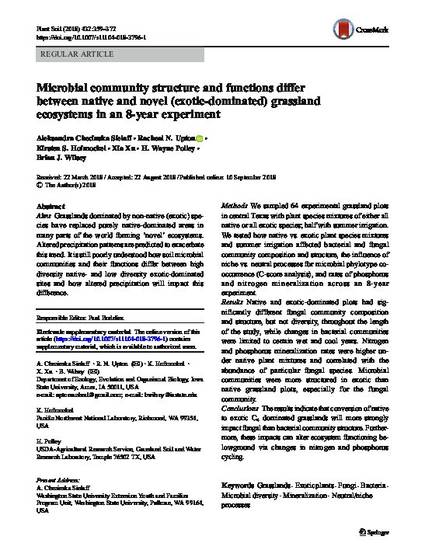
A Grasslands dominated by non-native (exotic) spe- cies have replaced purely native-dominated areas in many parts of the world forming ‘novel’ ecosystems. Altered precipitation patterns are predicted to exacerbate this trend. It is still poorly understood how soil microbial communities and their functions differ between high diversity native- and low diversity exotic-dominated sites and how altered precipitation will impact this difference.
Methods We sampled 64 experimental grassland plots in central Texas with plant species mixtures of either all native or all exotic species; half with summer irrigation. We tested how native vs. exotic plant species mixtures and summer irrigation affected bacterial and fungal community composition and structure, the influence of niche vs. neutral processes for microbial phylotype co- occurrence (C-score analysis), and rates of phosphorus and nitrogen mineralization across an 8-year experiment.
Results Native and exotic-dominated plots had sig- nificantly different fungal community composition and structure, but not diversity, throughout the length of the study, while changes in bacterial communities were limited to certain wet and cool years. Nitrogen and phosphorus mineralization rates were higher un- der native plant mixtures and correlated with the abundance of particular fungal species. Microbial communities were more structured in exotic than native grassland plots, especially for the fungal community.
Conclusions The results indicate that conversion of native to exotic C4 dominated grasslands will more strongly impact fungal than bacterial community structure. Further- more, these impacts can alter ecosystem functioning be- lowground via changes in nitrogen and phosphorus cycling.
Available at: http://works.bepress.com/brian_wilsey/69/

This article is published as Sielaff, Aleksandra Checinska, Racheal N. Upton, Kirsten S. Hofmockel, Xia Xu, H. Wayne Polley, and Brian J. Wilsey. "Microbial community structure and functions differ between native and novel (exotic-dominated) grassland ecosystems in an 8-year experiment." Plant and Soil 432 (2018): 359-372. doi: 10.1007/s11104-018-3796-1.